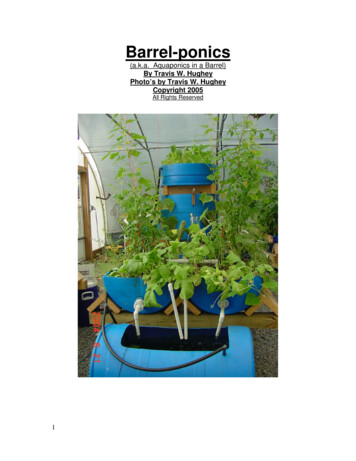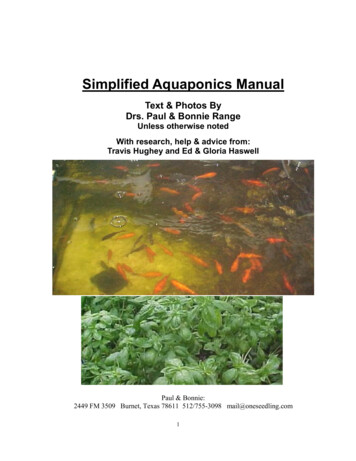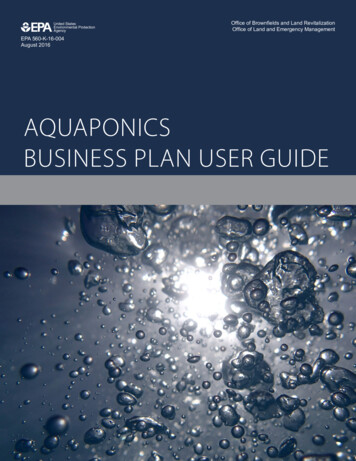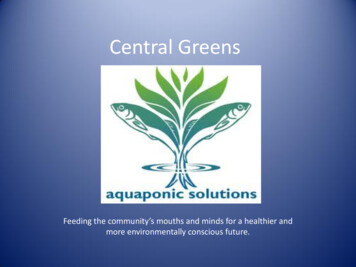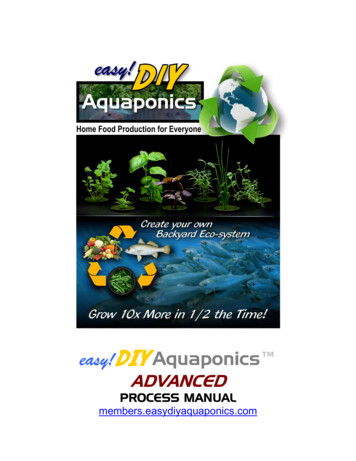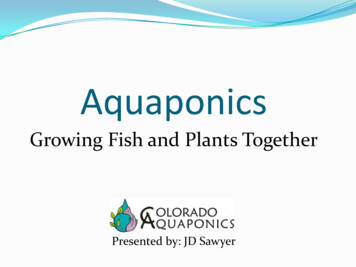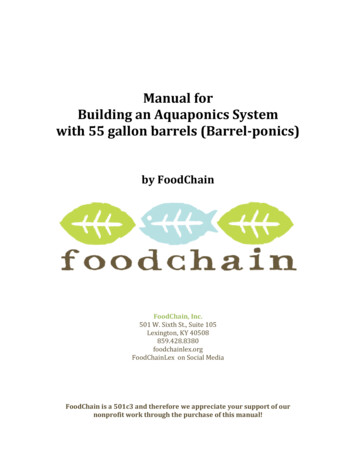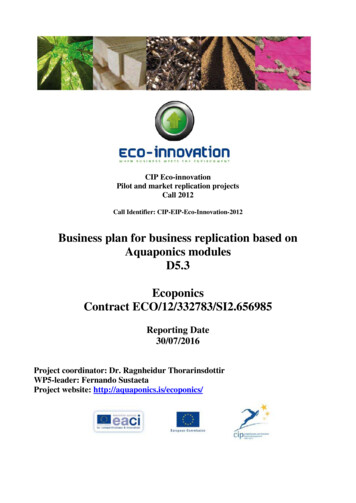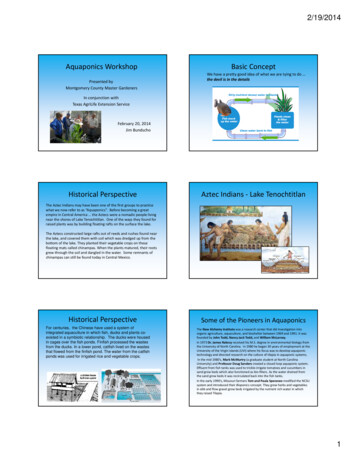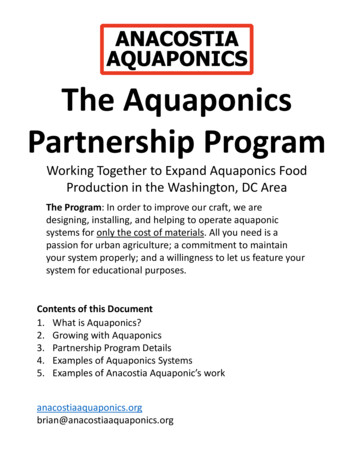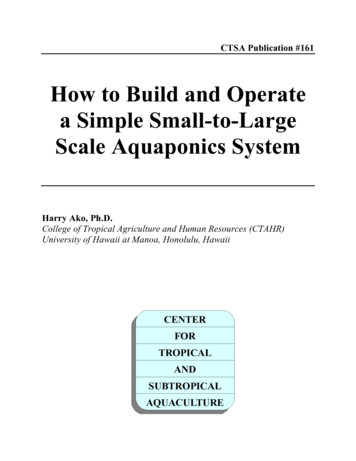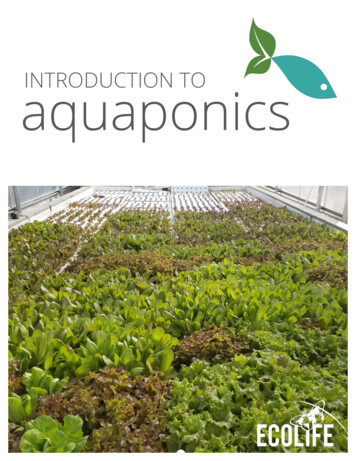
Transcription
INTRODUCTION TOaquaponics
This manual is brought to you by ECOLIFE.Saving Ecosystems. Saving Lives.www.ecolifeconservation.orgMission:ECOLIFE Conservation is an organization dedicated to a world in which peopleand nature prosper together. We focus on integrating community health andenvironmental sustainability through simple, adaptive approaches.The Challenge:Conventional agricultural practices wreak havoc on the environment in many ways,depleting vital resources and posing major health risks to both humans andwildlife. Additionally, the number one cause of species extinction is loss of habitat,which is overwhelmingly lost from the conversion of forest to farmland.Conventional agricultural practices are known to be: plays a major role in climate change the number one cause of species extinction a threat to vital resources a threat to human health - According to the WHO, nearly 3 million peoplesuffer from pesticide poisoning worldwide each year a threat to the environment as harsh pesticides and chemicals pollute theair, drinking water, and soilOur Approach:At ECOLIFE , we focus on using conservation as a tool that is adaptable andintegrative rather than confrontational. Our approach matches green technologieswith education to improve upon our use of precious natural resources such aswater, land, and forest.ECOLIFE Aquaponics2
How ECOLIFE HelpsAquaponics Education ProgramOur programs focus on aquaponics education which works to engage students in aunique classroom experience filled with hands-on science. Each program is designed tobreak from the conventional classroom setting and immerse students into a world wheresustainability is a concern that directly affects their future. The emphasis of our programis on project-based learning, which addresses community engagement and real-wordissues such as resource depletion.ECO-Cycle: San Diego, California and Across AmericaStart teaching aquaponics with the ECO-Cycle, our easy-to-use indoor garden system. Thissystem is designed to work with a standard 12″ x 24″ fish tank, and will provide studentswith a fun, daily reminder of the value of a sustainable food system. Give students theopportunity to care for aquatic animals while growing healthy veggies they will actuallyask to eat! We offer quarterly webinars and trainings for dedicated teachers who want toutilize an ECO-Cycle Aquaponics Kit and STEM curricula as learning tools in the classroom.ECO-Garden: San Diego, CaliforniaOur ECO-Garden Program is designed to be integrated with Next Generation ScienceStandards at middle and high schools. Classrooms will analyze the major global challengeof sustainable food production and come up with solutions that account for societalneeds and wants. Students work together to design an aquaponics system that ispractical, easy to maintain, within the given budget, and allows for scalable foodproduction to best fit the needs of the school. We teach the students to becomeaquaponics experts and share detailed descriptions and presentations of what they havelearned to other classes at their school. Current projects for this program will conclude inFall 2017.How Do I Get Started?To begin the application process, please review our eligibility requirements and submityour grant application on our website. You can also adopt a classroom and provide thisprogram to a teacher of your choice. We offer trainings, curriculum, and workshops forany interested educators - please contact us today for more information!ECOLIFE Aquaponics3
Table of contentsIntroduction to Aquaponics . 5The Nitrogen Cycle . . 7OverviewPlants 8Fish . . . 9Aquaponic Methods . . . 13Filtration and Cycling . . 17Setting up Your SystemBasic parts and supplies . . 19Water Quality . 23Aquaponics Resources 24ECOLIFE Aquaponics4
introduction to aquaponicsWhat is Aquaponics?Aquaponics is a sustainable method of food production combining aquaculture (raisingaquatic animals) and hydroponics (cultivating plants in water). In this circulating system,fish waste acts as a natural fertilizer for plants, plants then take up those nutrients andreturn clean water to the fish. Perfect harmony! Aquaponics is especially valuable in areaswhere land and water aren’t plentiful. Aquaponics is beneficial for everyone who wants togrow food, and it can be done just about anywhere that has access to clean water andenergy.ECOLIFE Aquaponics5
Why Use Aquaponics?Aquaponic systems operate with little environmental impact to produce highquality, hormone-free fish and organic vegetables, without the use of artificialfertilizers, harmful pesticides, and dangerous herbicides.Aquaponics emphasizes water conservation. Generally, aquaponics uses 90% lesswater than conventional vegetable gardens and 97% less water compared tostandard aquaculture methods. Additionally, the recirculating system keeps wasteout of watersheds.Aquaponics is a versatile and adaptable method of sustainable farming. Systemscan be built on just about any scale and designed to fit in almost any space - talkabout efficient land use!ECOLIFE Aquaponics6
the nitrogen cycleThe Nitrogen Cycle - The Magic of the SystemNitrogen is an essential nutrient for plant growth and is abundant in a healthy aquaponicssystem. Nitrifying bacteria convert ammonia and ammonium (found in fish waste) intonitrates, a form of nitrogen that plants can use as fertilizer. You will find three forms ofnitrogen and two main types of bacteria in an aquaponics system:Forms of Nitrogen:Bacteria:1. Ammonia/Ammonium1. Nitrosomonas2. Nitrites2. Nitrospira3. NitratesRemembering the name of the bacteria is less important than knowing their functions.The first set of bacteria essentially consumes the ammonia/ammonium produced fromfish and converts it into nitrite. The second set of bacteria consumes the nitrites andproduces nitrates - the most accessible form of nitrogen for rapid plant growth!The Nitrogen Cycle DiagramECOLIFE Aquaponics7
plantsWhat Plants Can Be Grown?A wide variety of plants may be grown usingaquaponics. Here are a few plants that have grownsuccessfully using aquaponics: Green leaf, red leaf, and other leafy lettuces Bok Choi Swiss Chard Arugula Basil Mint Watercress Chives Microgreens Many common tropical plants / house plantsSome fruiting plants may have higher nutritionaldemands and therefore, will do best in heavilystocked, well-established systems. We recommendadding potassium sulfate (sulfate of potash) to yourwater to trigger flowering.These include: Tomatoes Peppers Cucumbers Beans Peas SquashECOLIFE Aquaponics8
fishWhich fish grow best?A wide variety of fish and other aquatic animals can be farmed in aquaponic systems.Freshwater, herbivorous or omnivorous fish are ideal choices for their sustainability, easeof feeding, and efficient conversion of feed. Here are the top five fish we recommend: TilapiaIdeal for large scale aquaponics systems Easy to breed, starting at 7-8 months of age Optimum temperature range between 65 - 85 F Grow fast – up to 500g in 6 months Can be harvested to eat and are an excellentsource of lean protein CatfishIdeal for large scale aquaponics systems 300 gallon tank necessary because catfish cangrow up to a size of 40-50 lbs. Grow very quickly Can be harvested to eat Optimum temperature range 75 - 86 F Can tolerate temperatures between 41 - 93 F Resistant to many diseases and parasites Can withstand a wide pH range KoiBeautiful and long life-span Most comfortable in 250 gallon tanks Can tolerate temperatures from 35-85 F Resistant to many parasites Can withstand a wide pH range ECOLIFE Aquaponics9
Goldfish TropicalPerfect for in-home aquaponics systems Widely available Produce waste quickly Inexpensive Can tolerate temperatures between 50-75 F Gentle community fish if placed with similarsized, non-tropical fish TropicalFishBeautiful and fun option Perfect for in-home and smaller aquaponicsystems Heater necessary Examples: suckermouth fish, cichlids, mollies,clown loaches, tetras Or smaller tanks try the Albino BushynosePleco, which grow no longer than five inches gion.Other options of fish to consider are: Pacu Trout Crappie Barramundi Silver perch Golden perch Yellow perch Freshwater prawns CrayfishECOLIFE Aquaponics10
Some Notes on TilapiaTilapia has become a very popular fish to use in aquaponicsbecause they can handle a wide range of water quality. Due totheir large size, rapid growth, and palatability, a number oftilapiine cichlids are at the focus of major aquaculture efforts,specifically various species of Oreochromis, Sarotherodon, andTilapia, collectively known colloquially as tilapias. Like otherlarge fish, they are a good source of protein and a populartarget for artisanal and commercial fisheries.Mozambique Tilapia (Oreochromis mossambicus) is native toMalawi, Mozambique, Swaziland, Zambia, Zimbabwe and SouthAfrica. The Mozambique Tilapia has been introduced to manytropical and subtropical parts of the world, as well as to somewarmer temperate regions. The Mozambique Tilapia isconsidered a freshwater species but it can be found inestuaries and coastal lakes as well, especially in the southernpart of its geographical range.BreedingBreeding Mozambique tilapia is not difficult and the fish can start reproducing at 78 months of age. Males and females are very similar and can be difficult to sex. Oneof the easiest ways of obtaining a pair is to let at least 5-6 fishes grow up togetherand form their own pairs.Before any spawning takes place, the male will dig out a saucer-shaped nest on thesandy bottom. During spawning, the female releases her eggs into the nest. Thefemale waits until the male has fertilized the eggs in the nest. She will then pickthem up and keep eggs, larvae and small fry protected inside her mouth until thefry are large enough to be released. The eggs will normally hatch after 3-5 days, butit will take 10-14 days before the fry are released.Housing Fingerling tilapia may be reared in small aquariums but will eventually require alarge tank or pond, as they can reach 16 inches or more in length. 55 gallon barrels work great for growing tilapia to plate size, 1 – 1.5 lbs. As a guideline, the ratio of fish to water capacity is approximately one pound offish for every five to ten gallons of water.
Feeding Feed fish as much as they will eat in three to fiveminutes, three times per day. Allow four to fivehours between feedings for optimal metabolism Take care not to overfeed fish Provide a high-quality fish food of appropriatesize – fingerlings will take a much smaller pelletsize than juvenile and adult fish An adult tilapia will eat approximately 1% of itsbodyweight per day Fish fry (babies) will eat as much as 7% Fish that are not eating may be stressed due to:high ammonia levels, outside of their optimaltemperature range, lacking sufficient oxygen(discontinue feeding if dissolved oxygen dropsbelow 3ppm)Water TemperatureThe optimal temperature for Mozambique Tilapia is 75 – 85 Fahrenheit.Water Quality Tilapia thrive best in a pH of 6.5 to 8.0. Ammonia and nitrite levels should be less than .25 ppm. High ammonia andnitrite levels are the number one killers of fish in an aquaponic system. Oxygen Provide plenty of aeration in your fish tanks with a strong water flow. Avoid overfeeding or overcrowding the fish. Fish gasping for air at the water surface is a sign they are lacking oxygen.HarvestingTilapia are generally ready to harvest at 6 - 9 months of age but growth rate isdependent upon feeding regimen and the number of fish in a system.ECOLIFE Aquaponics12
Aquaponic methodsThere are three primary growing methods in aquaponics: Nutrient Film Technique(NFT), Ebb & Flow, and Raft or Deep Water Culture (DWC).Nutrient Film Technique (NFT) is the most popular technique used in hydroponicsand is easily adaptable for use in aquaponics. With this method, a thin layer ofwater containing dissolved nutrients from the fish tank is pumped through the bareroots of the plants in a watertight gully, or channel. The depth of the re-circulatingstream is very shallow, allowing for an abundant supply of oxygen to reach theplant roots. The main advantage of the NFT system is that the plant roots areexposed to a continuous supply of water, oxygen, and nutrients. A downside of NFTis that it has less buffering against interruptions in the flow, e.g. power outages, butoverall it is a very productive technique.ECOLIFE Aquaponics13
Another widely used method by backyard growers is Ebb and Flow Aquaponics. Thegrowing area is a wide deep container with sufficient surface area. This container isfilled with gravel, LECA, or other soil-less growing medium where the vegetablescan be planted. The water pump is controlled by an adjustable timer which is usedto circulate water to fill the tub in an “ebb-and-flow” manner. As the pump runs, thegrow bed is saturated with water. When the pump is off, the water slowly begins todrain back into the fish reservoir. As it drains, oxygen is pulled through the roots.An alternate means of providing water in an ebb-and-flow manner is through theuse of a bell siphon. A siphon is a mechanism for drawing water from a highercontainer to a lower container. Siphons can be adapted to control the flooding anddraining of grow beds in an aquaponics setup. In this usage, they are called autosiphons - siphons that can start and stop in response to changing water levels.Specifically, bell siphons and loop siphons are two useful and commonly usedtechniques for this application. Bell siphons can also be used in biological filters tocreate a wet/dry environment beneficial to aerobic nitrifying bacteria.ECOLIFE Aquaponics14
The bell auto-siphon consists of:1. A vertical standpipe2. A bell pipe placed over thestandpipe. The bell pipe isfreestanding, slightly tallerthan the standpipe it covers,and is fitted with an end-cap.Additionally, the base haspieces cut out to allow the freemovement of water.3. Small air holes are drillednear the bottom of the bellpipe to break the siphon whenthe water level has droppedlow enough.As the grow bed fills, waterflows up between the walls ofboth pipes then down theinside of the standpipe and outthe bottom. With enoughvelocity, a siphon is created,rapidly draining the water outof the container. When thewater level drops to the level ofthe air holes, the siphon isbroken, and the process beginsagain.ECOLIFE Aquaponics15
Raft or Deep Water Culture (DWC) is the most frequently used technique for largescale, commercial aquaponics. With this technique, the plants are grown onperforated rafts, usually made of Styrofoam or similarly buoyant material, whichfloat in dedicated water tanks. The roots of the plants are often bare and constantlyin the water. This is a highly productive method, which requires good aeration andintensive filtration to keep the water clean and clear of solids waste.ECOLIFE Aquaponics16
filtration and cyclingOverview of FiltrationThere are two primary types of filtration used in aquaponic systems: biologicalfiltration and mechanical filtration.Biological filtration or bio-filtration is the most critical forproviding proper water quality, and enhancing the well-beingof the fish. In bio-filtration, naturally occurring aerobicbacteria convert the toxic ammonia (NH3) produced by fish,decomposing fish waste, uneaten food, and dead plantmatter into nitrite (NO2) (also toxic) and then to relativelynon-toxic nitrate (NO3). Bio-filtration is achieved in a numberof ways in these systems, but all work on the same basicprincipal of moving oxygenated water through an inertmaterial with high surface area in which the nitrifyingbacteria colonize. One type of bacteria, Nitrosomonas, converts ammonia to nitrite,then a second type of bacteria, Nitrospira, converts that nitrite into nitrate which isin turn utilized by plants, or in the case of aquaponics, by the vegetables you aregrowing.Mechanical filtration is the removal of solid waste before being broken downby biological processes. This may be achieved by passing the water through a finematerial such as a foam sponge, filter sock, or other synthetic barrier, which trapsthe solids. The mechanical filter is manually removed and cleaned on a regularbasis. The manual removal of organic solids benefits the system by taking some ofthe demand off of the biological filter, reducing the amount of oxygen used bybacteria in the mineralization and nitrifying processes. This is important, as yourfish need oxygen as well. If there is too much solid waste in the system – uneatenfood, plant matter, etc., the dissolved oxygen may drop to dangerously low levels.The Initial CycleThese beneficial bacteria are ubiquitous and will eventually colonize where there isadequate oxygen and nutrients. Similar to the set up of an aquarium, a newaquaponics system must first be “cycled” prior to adding a large number ofECOLIFE Aquaponics17
fish. Cycling is the process of building up sufficient nitrifying bacteria colonies in thebio-filter to optimally handle the waste produced by the fish population. This isachieved by initially adding a few fish to the system. These fish will add enoughammonia to start the cycle. Gradually the ammonia level will rise. As this happens,the bacteria (Nitrosomonas) begin to make use of the ammonia, converting it tonitrite. As the ammonia peaks, the second type of bacteria (Nitrospira) begin toconvert the nitrite to nitrate. The cycle naturally stabilizes in about four to fiveweeks, after which more fish may be added to the system. This is best done on agradual basis – slowly building up to capacity.There are also alternative “fishless” cycling methods and head-start bacteriacultures available, which can help bolster and speed up the cycling processWater FlowIn aquaponic systems, a water pump is used to move water from the fish holdingtank through the filters to the plant roots and back to the tank. If multiple tanks orbarrels are used, the water may also be diverted to circulate through all of thetanks consistently, or a separate pump can be used for this circuit. The waterpump(s) should be of quality and power to provide an even, strong flow through allof the tanks and to the roots of the plants. Providing strong water movementthrough the fish tanks reduces dead spots and improves overall oxygenation.ECOLIFE Aquaponics18
basic parts and supplies Fish Tanks Grow Trays or NFT Channels Growing media Plumbing Biological Filter Mechanical Filter Water Pump Water Heater (if needed) Air pump / Diffusers Net Pots (for NFT) Lighting (if indoors)Fish Tanks, Ponds, and BarrelsA variety of containers may be utilized to hold fish, including aquariums, plasticstorage barrels, pond liners, etc. ECOLIFE’s indoor barrel system uses fourinterconnected 55-gallon plastic food-grade storage barrels to hold fish. We havehad good results with modified water storage tanks and raised concrete beds withpond lining.ECOLIFE Aquaponics19
Grow Trays and NFT ChannelsSpecialty growing trays and NFTchannels are available throughhydroponic and agricultureequipment suppliers. Plasticcement mixing trays and plasticstorage containers of appropriatesize can work well as growing trays,and rain gutter downspout can beeasily adapted to accommodategrowing pots. Both items are readilyavailable through hardware supplyretailers.Grow MediaHydroton LECA (lightweight expanded clay aggregate) is apopular hydroponic grow media used for aquaponic growing. Itis inert, reusable, and highly porous, providing extensive surfacearea for biological filtration. LECA is widely available in the USthrough hydroponics supply houses. Other good options forgrow media include quartz gravel and rockwool – a specialtyproduct for hydroponic growing. Ideally, the media should beinert and composed of varying pebble sizes to ensure that thereis interstitial space necessary for water flow and root growth.Biological Filter MediaThis is the material used to provide a growing surface for beneficial nitrifyingbacteria. There are many specialty plastic and ceramic bio-media products that maybe used for this application, as well as other generic materials. Lava rock, forexample, works well and is inexpensive and widelyavailable. Plastic onion bags and polypropylenestrapping can also serve as inexpensive andeffective bio-media. We have had great resultsusing a commercial pond filter media calledMatala , which can be obtained through mostpond equipment suppliers. It works well for oursystems because it is available in a 21” roll, whichhappens to fit perfectly inside a standard 55-gallonbarrel. Matala has a very high surface areaECOLIFE Aquaponics20
making it an effective bio-media. It is available in four densities, which may bestacked from less dense to most dense for optimum filtration.Mechanical FiltersAs discussed earlier, mechanical filtration functions allow the removal of solidwaste before being broken down by biological processes. This may be achieved byplacing a polyester filter sock, foam sponge, or similar barrier in the line of waterflow. Filter socks and other specialty filter materials are available through aquariumand pond suppliers. A mechanical filter can also be easily constructed with partsfrom the hardware store. For example, a length of rain gutter drilled with manysmall holes for drainage and lined with foam sponge or polyester filter floss may beplaced in-line where water returns to the barrels. Mechanical filtration works bestwhen the filter media (sponge, etc.) is not submerged in the water, but positionedabove the water line to catch water as it flows from the growing channels back tothe fish. The sponge may then be removed, cleaned, and replaced on a regularbasis. For larger systems, sand filters, settling tanks, and other commercial filtersare a good investment and will go a long way in providing stable water quality.Net Pots or Basket PotsThese are another specialty item available through hydroponicequipment suppliers. They are plastic pots that are perforated toallow water flow while containing the soil-less growing media. Thenet pots are made in various sizes. We use the 3” pots for most ofour NFT channel systems.ECOLIFE Aquaponics21
Lighting for Indoor SystemsThe sun is the finest light source for aquaponics. For growing indoors, however,there are a number of artificial light options for indoor gardening, including highoutput fluorescents, metal halides, mercury vapor bulbs, LEDs, and plasma lights.We use T5 high output fluorescent fixtures and LEDs with relatively low heat outputand minimal power consumption. This has worked very well for leafy greens likebasil, lettuce, and chard. Some vegetables may require more intense lighting whengrowing indoors.Water HeatersIf culturing fish from tropical regions, such as the commonly farmed Mozambiquetilapia, a submersible water heater will be required. Wattage will be determined bythe system’s capacity and ambient temperature of the surrounding area. Fortabletop units of 10 – 40 gallons, standard aquarium heaters in the range of 100 –250 watts are adequate. For larger systems or those that are exposed to outdoortemps, high wattage models are required. During colder months when the ambienttemps are in the low 50s F or colder, we add an additional heater to stabilize thetemperature at 80 F. As an alternative, passive solar heating systems may beemployed to manage water temperature. These units are a bigger up frontinvestment but will save a great deal of electricity in the long run.Air Pumps and Air StonesAeration is vital to maintaining adequate oxygenlevels for fish respiration. Providing extensive watersurface area, along with water surface agitationhelps to increase the dissolved oxygen in the water.Supplemental air pumps and diffusers, along withairline tubing and gang valves to manage flow canalso be used to provide supplemental O2. Like muchof this equipment, air pumps and peripheral itemsare available in a large variety of sizes and powerratings. Most aquarium models are rated to a galloncapacity. In order to have sufficient aeration, it is best to go one or two sizes higher.The depth of the water is also an important consideration when selecting an airpump. A diffuser in deep water requires a much stronger air pump than that of ashallow system of the same capacity. Air pumps and aeration accessories areavailable through most pet shops and aquarium suppliers.ECOLIFE Aquaponics22
water qualityRainwater and clean well water are ideal sources for filling an aquaponic system.Many of us, however, are limited to municipal water to charge the system. While insome regions water may be ready to use right out of the tap, many municipalsources add chlorine and chloramine to the water for disinfectant purposes. Thesecompounds make the water safe for humans to consume but are toxic to fish andthe bacteria in the bio-filter. There are a number of water conditioners available atpet and aquarium shops used to neutralize these chemicals. Check to make surethat they are safe for use with fish and plants that are intended for humanconsumption. An easy and safe alternative is ascorbic acid or Vitamin C. Adding 500mg of ascorbic acid per 50 gallons of water effectively neutralizes chlorine. Medicalgrade carbon filters may also be used to safely remove these harmful compoundsfrom tap water. Replacement water, (water that is added to the system for a waterchange or due to evaporative loss) will require little water treatment in establishedsystems. pH: A neutral pH (7.0)is ideal. This is acompromise betweenthe optimal ranges forthe fish, the plants,and the bacteria. Fishtypically thrive best ina pH of 6.5 to 8.0. Forplants optimum pH ranges from 5.0 to 7.0. Nitrification (the bacterialconversion of ammonia to nitrite and then nitrate) works best at a pH of 7.5 to8.0. Test pH at least once a week to keep track. Ammonia and nitrite levels should be less than .25 ppm. High ammoniaand nitrite levels are the number one killers of fish in an aquaponic system.Ideal ranges for your system are included in the table below.ECOLIFE Aquaponics23
ResourcesFood Grade Barrels and Containers:o San Diego Water Recycling - www.sandiegowaterrecycling.como Hydrofarm - www.hydrofarm.comGrow trays, Bell siphons, and Other Specialty Supplies:o The Aquaponic Source - http://www.theaquaponicstore.como Growers Supply - http://www.growerssupply.como Aquatic Warehouse - http://www.aquaticwarehouse.como Innovative Growing Solutions, Inc. - www.igshydro.como API Water Quality Test Kit http://www.apifishcare.com/product.php?id 580#.WKuL6RIrLUYLECA, Grow Pots, Lighting, and Indoor Growing Supplieso Greentrees Hydroponics - www.hydroponics.neto Innovative Growing Solutions, Inc. - www.igshydro.como Peaceful Valley Farm Supply - www.groworganic.com/Water Pumps, Bulkhead Fittings, and Plumbing Supplieso Grangetto’s - www.grangettos.como Pentair - http://pentairaes.comFish & Bulk Fish Foodo Tilapia Mama - www.mybackyardfishfarm.como Alpine Fisheries - www.alpinefishery.neto Aquaponic Source - www.theaquaponicstore.como Brine Shrimp Direct - www.brineshrimpdirect.como Angels Plus - www.angelsplus.comWorkshopso Green Acre Aquaponics, Colorado - http://greenacreaquaponics.com/o International Aquaponics and Tilapia Aquaculture Course, University of the VirginIslands: ult.aspxo Nelson and Pade, Wisconsin - Workshops & Training; Aquaponics, Hydroponicso Eden Aquaponics, California - http://edenaquaponics.com/o Nor Cal Aquaponics - California - http://norcalaquaponics.com/ECOLIFEConservation 350StatePlace Escondido,CA92029 760.740.1346 ionfromECOLIFE. 2017ECOLIFE Aquaponics24
quality, hormone-free fish and organic vegetables, without the use of artificial fertilizers, harmful pesticides, and dangerous herbicides. Aquaponics emphasizes water conservation. Generally, aquaponics uses 90% less
